Per-user, or per-seat, billing is a subscription billing model where the number of users with access to the solution determines the payment each billing cycle. It’s easy for companies to understand the cost of growing their use of your services because they simply pay more when they add a new user. This means scaling occurs linearly and customers can predict the cost of using your services as they expand. If you’ve been wondering if there’s a SaaS billing model that you can implement quickly and easily, per-user billing may just be the answer.
Originating from per-license models, it rose to prominence following the birth of SaaS companies in the late 90s and has remained a dominant billing strategy to this day. A 2021 survey revealed that 41% of SaaS companies employ per-user pricing—even enterprise-grade products like Microsoft Dynamics 365 solutions offer licensing on a ‘per user/month’ basis.
Although many feel that the pricing strategy has become outmoded due to the limiting nature of billing per user, it still has a place. The model’s biggest strength is its user-friendly nature for both the seller and buyer—providing standardization and simplicity to accounting teams. This blog will give you the tools you need to determine if per-user billing is the right pricing strategy for your business.
Want to explore a specific aspect of per-user billing? Skip ahead by clicking on the topic.
- Unpack the pros
- Unpack the cons
- 3 per-user pricing strategies
- Understand revenue recognition and deferred revenue
- Metrics to consider before implementing per-user billing
- Implement and manage the complexity
Understand the benefits and challenges of per-user billing
Unpack the pros of per-user billing
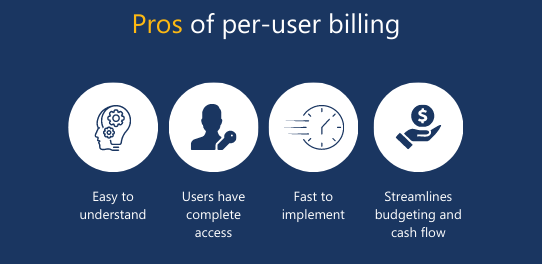
- Easy to understand. Calculating how much your customer will need to pay is a straightforward process based on headcount. For some customers, the complexities of other billing models are too much, and they will appreciate the simplicity of this model.
- Users can have complete and equal access to the product. Each account can allow users the full functionality of the product or service, which means they don’t need to worry about hidden fees for additional features.
- Fast to implement across an organization. Unless you opt for a model that offers different access levels based on defined roles, each user’s account should have the same permissions. Once a customer sets up user accounts, there is little else that needs to happen before they can start to use the solution—resulting in a quick deployment.
- Streamlines budgeting and cash flow. Since it’s relatively simple to calculate how much your customers owe, it’s also easier to predict your cash inflow and budget accordingly.
Unpack the cons of per-user billing
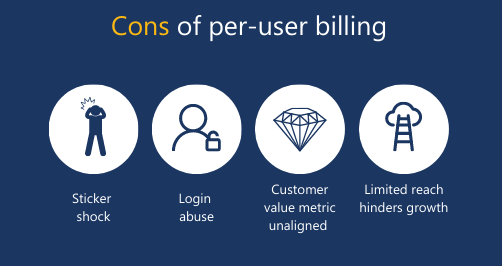
- Customers can experience sticker shock. As your customers outgrow their initial tier, they might be surprised by the increase in price, which may increase your churn rate.
- Login abuse. Multiple individuals using a single account is a pervasive problem with this pricing strategy as many try to find a way to avoid paying more for the same product.
- Number of users is not always a customer value metric. It can be difficult for companies to justify the costs of a solution if the number of users is not integral to defining its value.
- May hinder long term growth if customers experiencing rapid growth feel like they are being penalized by a per-user model. Over time this can result in a high churn rate or poor customer retention.
3 per-user pricing strategies with examples
There are several different ways to charge per user, so this list is to help you determine which approach might work best for you. The list below quickly summarizes the various strategies, and you can click the pricing strategy of your choice to jump ahead:
1. Per-active-user pricing | Explanation and example
Many companies take inspiration from usage-based billing models, modifying per-user pricing to charge per active user rather than the total number of users. A tactic that is particularly useful for large companies whose employees need access to the full functionality of a product, but not all the time or not all at once.
This approach enables your customer to keep track of Monthly Active Users (MAU), which could be a very valuable metric depending on their industry. For instance, LogSentinel is a security information and event management (SIEM) solution that base billing on active users. Given that the actual MAU will fluctuate, it’s good practice to ask prospective clients to estimate their usage to provide them with a quote. Understanding expected use allows you to predict revenue better and help combat the confusion sometimes associated with flexible pricing.

2. Introductory free tier | Explanation and example
Another strategy to consider is incorporating an unlimited free tier or the freemium model as your lowest tier. That way you offer customers an entry point to become familiar with the basics of your solution, potentially still earn revenue from ads, and ultimately, entice them to invest in your per-user or per-active-user tiers.
If you need to add extra incentive for your customers to upgrade, you can try applying some of the principles of subscription pricing psychology. By limiting the freemium tier’s functionality or reducing the number of accessible features, you can nudge your customers towards choosing the next tier up. Just be careful not to water down your services too much or else your prospective customers may be left with a bad impression.
Azure DevOps Services is an example of a solution that utilizes free tiers as an introductory point. Their basic plan starts out free for the first five users and then is $6 for each additional user and includes all the services except for the test plans.
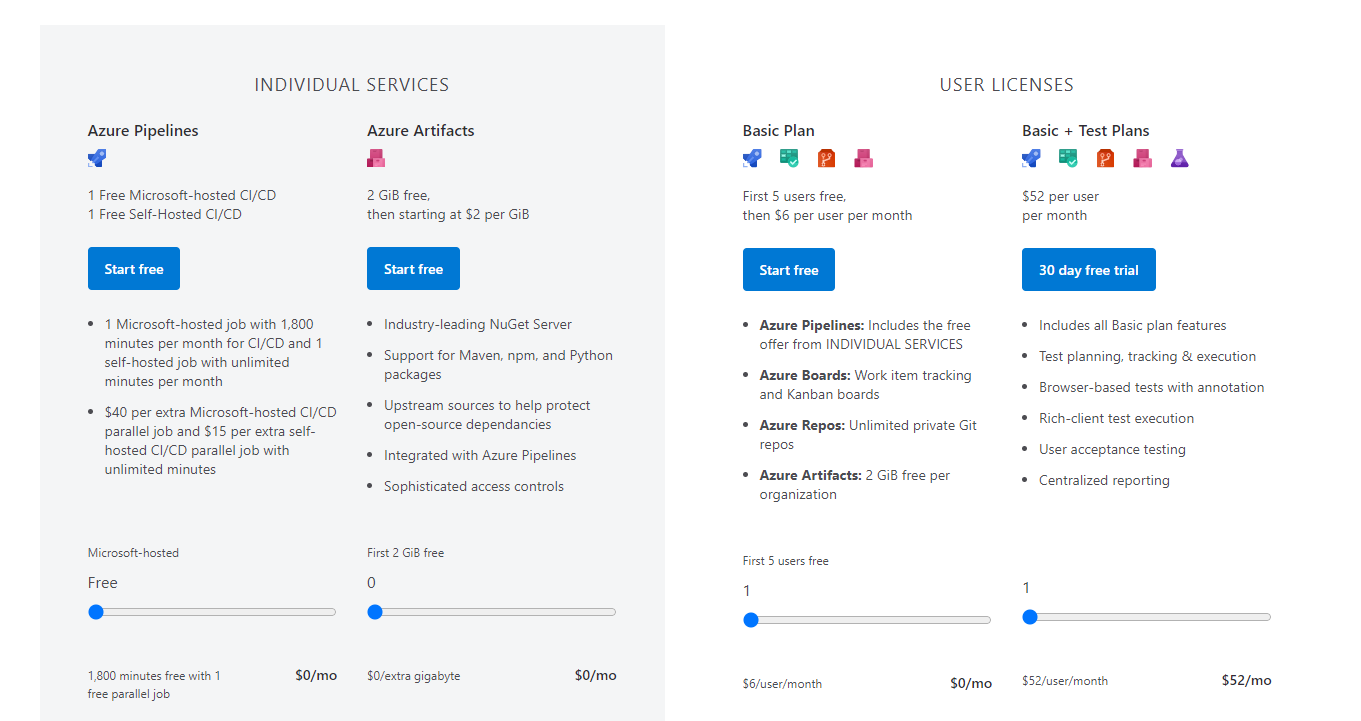
3. Per-device pricing | Explanation and example
Rather than fighting the login abuse trend, some companies have redefined what “per-user” even means and have incorporated login abuse into their model. In today’s world, people who are “plugged in” typically have more than one screen each. 85% of Americans own a smartphone and the average American household has more than ten devices.
The prevalence of multi-device users prompted some companies to move to a billing model that charges for each device using the product. Charging per device can allow your company to inflate its revenue by steering customers towards higher pricing tiers and it can work as a proxy for the number of people using the service.
Netflix allows for up to four user profiles per account, but the number of devices you can stream from at the same time depends on your pricing tier. It’s unlikely that one person would be streaming videos on multiple devices at the same time, so this model successfully combats login abuse.
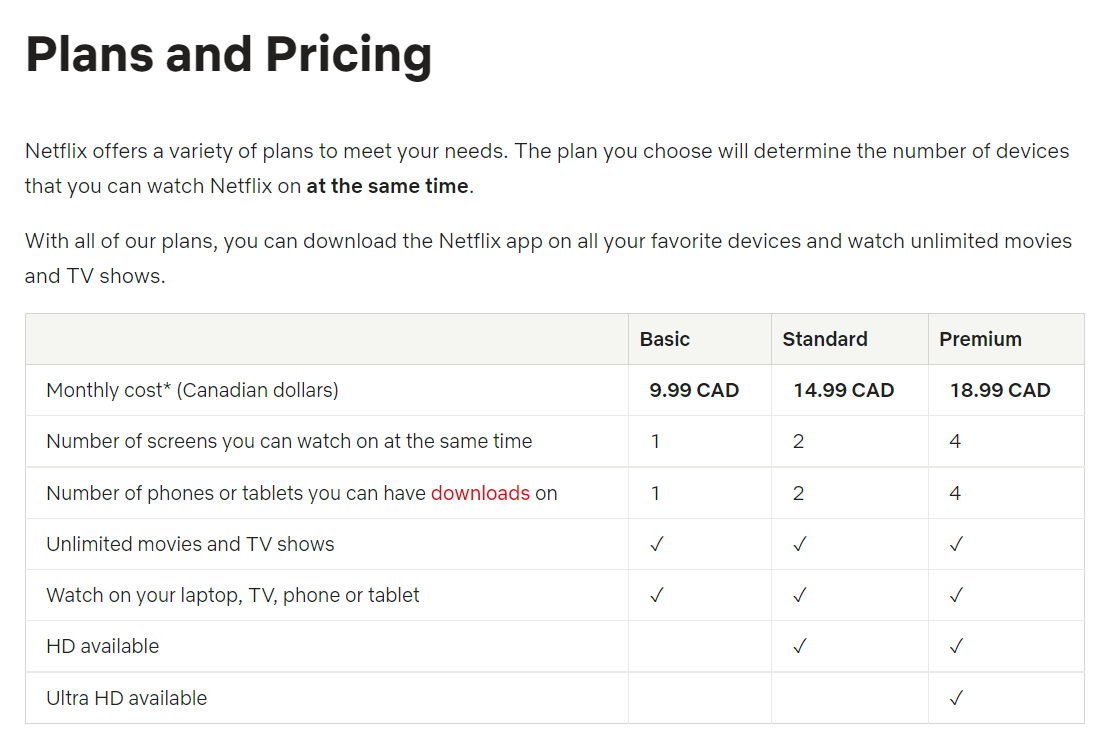
Revenue recognition for per-user billing
Understanding the process of revenue recognition is essential to managing per-user billing and retaining compliance with accounting standards like ASC 606 and IFRS 15. As with any subscription pricing strategy, you must only recognize the revenue after delivery of the service or product.
Suppose you charge a flat rate for a defined number of users each billing cycle and bill your client at the beginning of the period. In that case, you must count the revenue as deferred revenue until the delivery of the service is complete at the cycle end.
However, if you plan on charging per active user each billing cycle, you will need to calculate the number of active users by the end of the billing cycle. Still, you can recognize the revenue as soon as you receive it because the total depends on the service provided.
Metrics to consider before implementing per-user billing
Before deciding whether per-user billing is the right pricing model for your company, it’s essential to consider your customers’ value metrics. If you answer ‘yes’ to the following questions, per-user pricing is likely right for you:
- Will each user receive differentiated value from accessing your product?
- Does your customer require standardization across their department or company?
- Does your solution allow users to collaborate and share, perhaps through network effects?
- Will your customer require budget predictability and control?
- Does your customer need easy-to-understand pricing?
- Are usage metrics, like monthly active users (MAU), commodified in your customers’ industry?
Managing the complexity of per-user billing
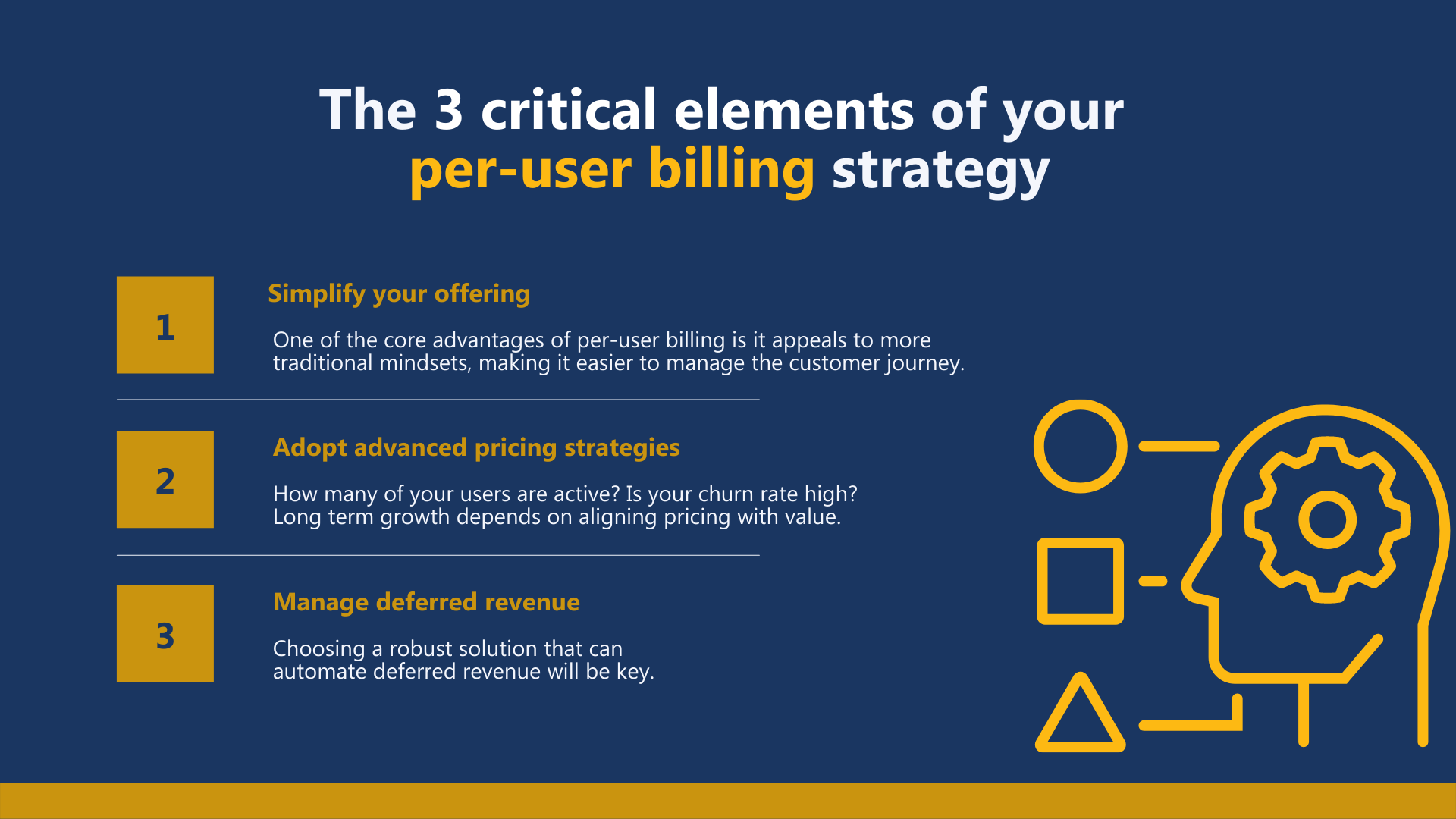
It perhaps comes as no surprise that companies will not implement per-user billing effectively if they rush it. Here are the three critical elements of the billing model that will aid your growth journey.
The 3 critical elements of your per-user billing strategy
1. Simplify your offering
If you intend to use this billing strategy, ensure that it simplifies your offering overall. Per-user pricing has remained a popular strategy because it’s easy to understand for customers and businesses alike—enabling easier management of the customer journey. You will lose the competitive advantage afforded by this billing model if your customers are confused.
2. Adopt advanced pricing strategies
For your company to achieve long term growth, it’s crucial that your pricing strategy aligns with the customer perceived value. Regularly revisiting your billing model with insights from market research will allow you to adapt to better fulfill your customers’ needs. To get you started, this blog covers three types of advanced per-user billing models that were created to account for more complex usage.
3. Manage deferred revenue
Without a powerful recurring billing solution that allows you to automate deferred revenue, even the most straightforward pricing strategies suffer. Maintaining compliance with accounting standards like ASC 606 and IFRS 15, as well as error-free invoicing are essential to avoiding penalties and providing excellent customer service. Subpar management of subscription services is guaranteed to increase your churn rate and reflect negatively on your brand.
Check out our other pricing model guides:

